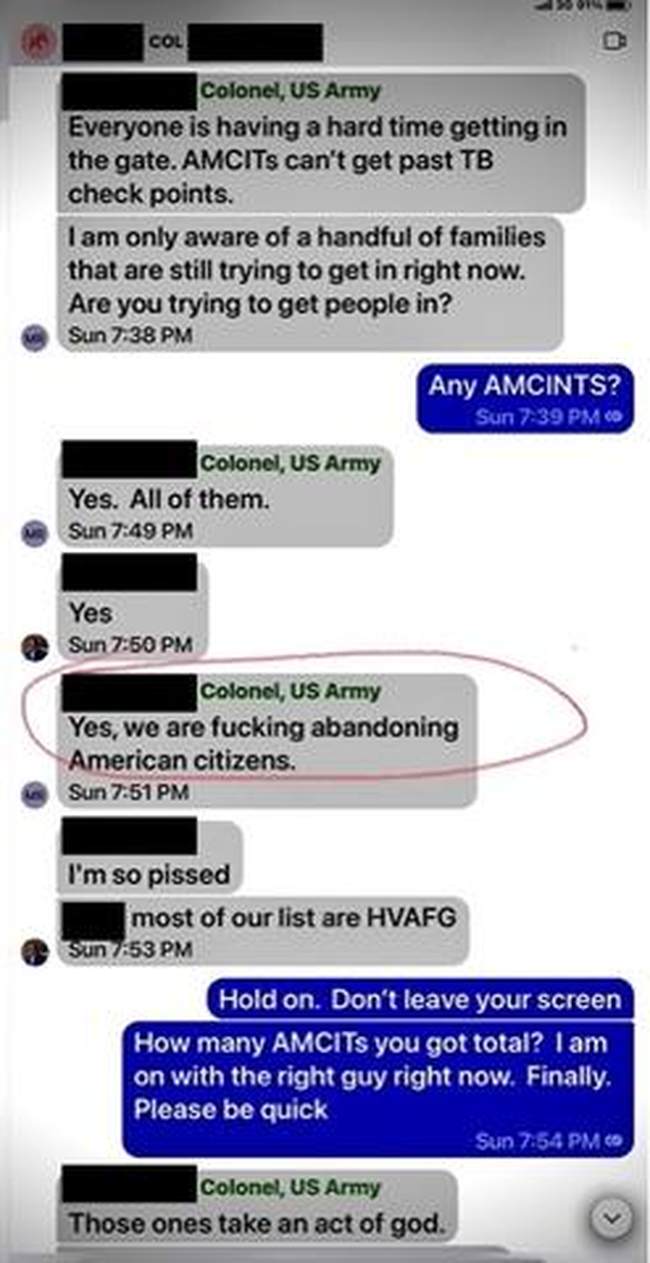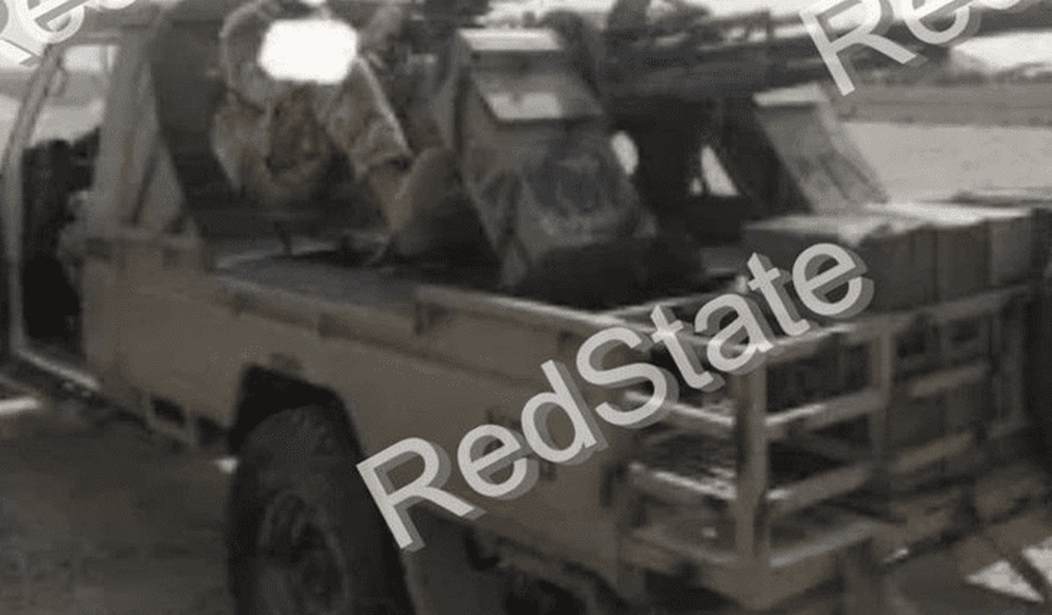RedState’s exclusive report about Afghan evacuees being abandoned in Afghanistan so Maj. Gen. Chris Donahue could have a Taliban Toyota Hilux w/rear-mounted Russian ZU-23 anti-aircraft weapon (war trophy) loaded on one of the last C-17s out of Kabul has rattled some nerves at Fort Bragg, in the Pentagon, and beyond. In addition to the curious statement provided to RedState hours after its publication by Army Col. Joe Buccino, spokesman for the 101st Airborne, its publication spurred a piece in Task & Purpose purporting to be the “true story” of what happened – and which conflicts with the statement Buccino provided and with other evidence/facts. Before the Task & Purpose piece was published, though, I’d received another statement from Col. Buccino that conflicts with some of the information in Task & Purpose and which will be published in this piece. In addition, Breitbart published a story about the chaotic last two weeks in Afghanistan that contained some interesting tidbits from people on the ground.
Basically, the narrative put forth in the Task & Purpose story is that it was a Toyota Land Cruiser and not a Hilux; that it was an Afghan National Army truck (ANA) and not Taliban; that no evacuees or American citizens were denied passage to the United States due to the truck taking up space in a C-17; that all appropriate paperwork was filled out for the truck to become a museum piece; and that an ambitious Iraqi-born Private traded some ANA soldiers two cans of chew for the truck.
The narrative set forth by both Task & Purpose and Col. Buccino is simply not credible. I’ll go through the elements of the narrative then point out the conflicting statements or evidence.
1. When Fort Bragg soldiers arrived in Kabul they were “light on equipment” and didn’t have machine guns.
Lt. Col Andy Harris and Private First Class Alsajjad Al Lami spoke with Task & Purpose, saying that when the 1st Battalion, 504th Parachute Infantry Regiment arrived at Hamid Karzai International Airport (HKIA) just after 7 am local time on August 16 they were “light on equipment.”
“The focus was getting troops into Kabul, he said, which meant there wasn’t much room for ‘our heavy equipment or vehicles with our heavy machine guns.'”
“We just had our basic weapons, we didn’t have any heavy machine guns, any gun trucks or anything,” said Pfc. Al Lami.
However, according to a Breitbart article published within hours of the Task & Purpose piece, a US service member who did not want to be identified said they found machine guns, RPGs, and rocket launchers there that had been abandoned by Afghan security forces:
Afghan security forces also abandoned thousands of guns and munitions at the airport. “There’s just guns laying everywhere and RPGs, AT4 [rocket launchers], grenades, machine guns, rifles, pistols, explosives, et cetera,” he said.
And, the situation at HKIA, the Breitbart article mentions the U.S. military using Apaches as part of the effort to gain control of the airport and the assistance of Turkish forces:
The U.S. military tried to use Apaches to disperse some of the people flooding onto the runways.
Around the same time, U.S. and Turkish forces — who were previously in charge of airport security — fired warning shots to try to clear the runways. At least one Afghan man was accidentally injured by a U.S. service member firing a warning shot. The man later died of his injuries.
2. US paratroopers, led by an Iraqi-born PFC who served as translator, traded ANA troops who were changing locations two cans of chew for the keys to the Land Cruiser.
According to Harris and Al Lami, the US Army acquired the “truck” from ANA troops who were changing locations.
[T]he Afghan forces had their own gear, including an olive green Afghan National Army truck mounted with a Russian-made 14.5mm ZPU-2 anti-aircraft gun. On Aug. 17, when the Afghan troops informed Bravo Company that they were moving to another area of the airport, the paratroopers asked if they wouldn’t mind handing over the keys.
“There were two guys standing by the truck, and we asked them if they had the keys,” Al Lami said. “They were like, ‘Yeah we do have the keys.’ And they gave us the keys for two cans of dip.”
[H]ad it not been for Pfc. Alsajjad Al Lami, the Iraqi-born U.S. Army soldier, the Toyota Land Cruiser might have remained where it was, abandoned by Afghan forces, instead of being used by American troops to guard the airport and keep the surrounding Taliban fighters at bay.
Since translators were also scarce, Al Lami served as translator, according to the article. In addition, he reportedly had some experience that would be helpful in using the Russian anti-aircraft gun (as if our Paratroopers couldn’t figure it out):
“Al Lami, 25, was born and raised in Iraq. He said his father worked as a translator for the U.S. military there, which instilled in him a deep desire to serve in the U.S. Army. After he graduated high school, Al Lami said he had to complete a mandatory service obligation in Iraq’s military, but he only ended up serving for six months before he left for college in the U.S….
“Al Lami knew how to work the ZPU-2 thanks to his short stint in the Iraqi military. “
One problem with that story. Iraq hasn’t had a mandatory service obligation since 2003, when Al Lami would have been six years old, so he couldn’t have completed a mandatory service obligation when he was 18. That brings up another question – how did he have so much knowledge about how to operate a ZPU-2? And, was it a ZPU-2 or a ZU-23?
There is a Land Cruiser pictured in the Task & Purpose article, but is that the same truck that Donahue allegedly prioritized on that last day over evacuees? Further down in the same piece a statement from Col. Brett Lea, a spokesman for the 82nd Airborne Division, contradicts both the make of the truck and from whom it was acquired (emphasis added):
“No personnel were removed from any aircraft departing HKIA to make room for the Taliban Hilux.”
In his first on-the-record statement to RedState Col. Buccino, incredibly, used the exact same words. And, according to Buccino, he’s not even in the same unit as Lea. Buccino’s statement has an additional sentence, though, clarifying that it was seized from the Taliban.
“No personnel were removed from any aircraft departing HKIA to make room for the Taliban Hilux….
“The Hilux truck, taken from the Taliban at the airfield on August 17th, was loaded onto a C-17 for movement to the US on August 30th….
Lea could have used those words as well, but it’s unclear whether Task & Purpose published Lea’s entire statement. In any event, was it taken from the Taliban, or was it acquired through barter with friendly ANA troops? Those are quite different scenarios. Or, is it possible that, given the differences in description, that there are two trucks that were loaded onto C-17’s during the withdrawal?
3 The “truck” played a vital role in securing the airport and deterring Taliban fighters, and that’s why it’s coming to the US.
From Task & Purpose:
For days, the ZPU-2 was used by American troops as a show of force to the Taliban on the other side of the airport’s gate….
The truck served as a primary deterrent to Taliban fighters as U.S. troops landed in Kabul to assist with the massive evacuation effort there.
Maj. Gen. Donahue also gave a statement:
In a statement to Task & Purpose, Donahue said the story of the truck is “emblematic of the grit, discipline, and extreme competence” his paratroopers displayed at HKIA.
“This truck will sit at the 82nd Airborne Museum so that our Paratroopers, their families and future generations to come will know that when faced with a mission of unprecedented scope and complexity, the Paratroopers rose to meet this challenge,” Donahue said.
Buccino’s statement in my initial piece was a bit different, referencing “confiscating” the Hilux from “the Taliban,” and that confiscation led to the US regaining the tactical advantage at HKIA:
The truck, once all the way through customs and the military legal process, will serve as a symbol in the 82nd Airborne Division Museum on Fort Bragg of how the Division came into a chaotic situation and by confiscating the Hilux from the Taliban we quickly regained the tactical advantage in order to complete the mission.
Hmm. None of them mentioned the armed drones we had there, one of which was used as late as August 29 (in the horrific bombing, authorized by Donahue, that killed seven children), as more of a deterrent to the Taliban than an anti-aircraft gun (how many aircraft did the Taliban control in Kabul in mid-August?), or the Apache helicopters that were.
4. Nobody was removed from a C-17 to make way for the Hilux, and there was plenty of room on the planes.
In addition to stating that no “personnel” were removed from any aircraft to make room for the Hilux, Lea told Task & Purpose:
“In fact, aircraft space was not an issue at all in terms of getting American citizens, Afghan SIVs, or at-risk Afghans out of HKIA in the final days of the evacuation mission.”
Buccino, a spokesman for the 18th Airborne Corps, used the exact same wording. Unless there is a different definition, “personnel” doesn’t mean HVAFG, or “high-value Afghans,” or Afghan SIVs, or even American citizens. While one Army officer who spoke to RedState on condition of anonymity said that as long as American citizens, SIV holders, and the like got to the airport and past the Taliban there was space for them on the planes, we know from separate sources that soldiers in Donahue’s command were turning away people with the proper documentation from the gates and that the State Department was telling them to do so.
Michael Yon, a retired special forces soldier turned war correspondent, shared this screenshot with Just The News showing that the US military was knowingly leaving American citizens and high-value Afghans behind, some of whom were screaming at the airport gates. A US Army Colonel assigned to the 82nd Airborne said in one text message to Yon, “Yes, we are f***ing abandoning American citizens. I’m so pissed.”

Yon emailed a US Army Major the next day, expressing his displeasure.
“You guys left American citizens at the gate of the Kabul airport. Three empty jets paid for by volunteers were waiting for them. You and I talked on the phone. I told you where they were. Gave you their passport images. And my email and phone number. And you left them behind.
“Great job saving yourselves. Probably get a lot of medals.”
And we’re supposed to believe that it was all on the State Department? It’s definitely not on the soldiers at the gate, who were following orders from higher-ups. The Colonel told Yon that for high-value Afghans to get on the flights it would take “an act of God.” No, it would take an act of Donahue. If a two-star general wanted those people on the planes, they would have been there.
Buccino emailed an additional statement in the days after the original article was posted and asked that it be published in its entirety. I am publishing it as received, in its entirety, here, with my comments interspersed.
“This article is riddled with inaccuracies. Among them:
1. The Hilux is not “in a container truck on Fort Bragg.” The truck remains in Kuwait. If the truck is, in fact, on Fort Bragg, the reporter’s sources should be able to take a photograph and send it to RedState to prove me wrong here.
Again Buccino refers to the truck as a Hilux, but this time mentioned that it “remains in Kuwait.” In his first statement, he didn’t mention a particular country. Buccino then challenges RedState to have its sources take a photograph of the truck on Fort Bragg. This seems to be a very poorly veiled attempt to flush out RedState’s sources and is disturbing.
2. I never made any comment about the detonation set for remote destruction of the C-RAM. Destruction of a C-RAM system is not an area in which I have any training or knowledge. I also was never on HKIA, nor am I assigned to the 82nd Airborne Division, therefore, it would make no sense for me to comment on a matter I know nothing about. I am unfamiliar with the process of C-RAM destruction. Therefore, I would not comment on the matter.
There’s no evidence of Buccino being in Kabul during the withdrawal, and no assertion that he was. He isn’t assigned to the 82nd Airborne Division but is quoted as a spokesman for the 18th Airborne Corps, of which the 82nd Airborne is a part, in numerous news stories throughout the summer and during the withdrawal. In a Washington Examiner piece claiming that Donahue told a British special forces commander to have his troops stop operating outside the airport’s perimeter because “the British operations were embarrassing the United States military in the absence of similar U.S. military operations,” Buccino issued a denial on Donahue’s behalf.
Col. Joe Buccino, a spokesman for the XVIII Airborne Corps, denied that Donahue made such a request.
“The XVIII Airborne Corps denies the central thrust of this story,” the spokesman said. “Specifically, Gen. Chris Donahue, whose sole focus is security at HKIA, never made such a request to any British Army officials and would have no motive for doing so.”
How could he have known that if he wasn’t at HKIA and isn’t assigned to the 82nd Airborne Division?
Next, Buccino takes issue with this line in RedState’s initial piece, then distances himself from the MG.
A Pentagon source speaking on condition of anonymity told RedState that some in the chain of command have been interviewed about the incident, including Col. Joe Buccino.
Buccino states:
3. I am not ‘in the chain of command.’ I am nowhere in General Chris Donahue’s chain-of-command at all. We are not in the same unit. My only proximity to General Donahue is that we both live on Fort Bragg.”
While Buccino is literally correct, and there are some nuances that could be discussed there, it’s a silly argument because it has nothing to do with the extremely serious allegations in the piece and is merely an attempt to deflect. Also, as evidenced above, Buccino has been a spokesman for Donahue by virtue of his position with the 18th Airborne Corps. And, Donahue was a guest on Buccino’s podcast in early June 2021 – an episode in which Buccino heaps praise on Donahue. Yes, Fort Bragg is a massive installation, but for these two it’s a small world.
These conflicting statements from Army public affairs officials and the dubious report (or true story) of how the “truck” was acquired just lead to more questions – and they’re questions for which RedState is actively pursuing answers.















Join the conversation as a VIP Member